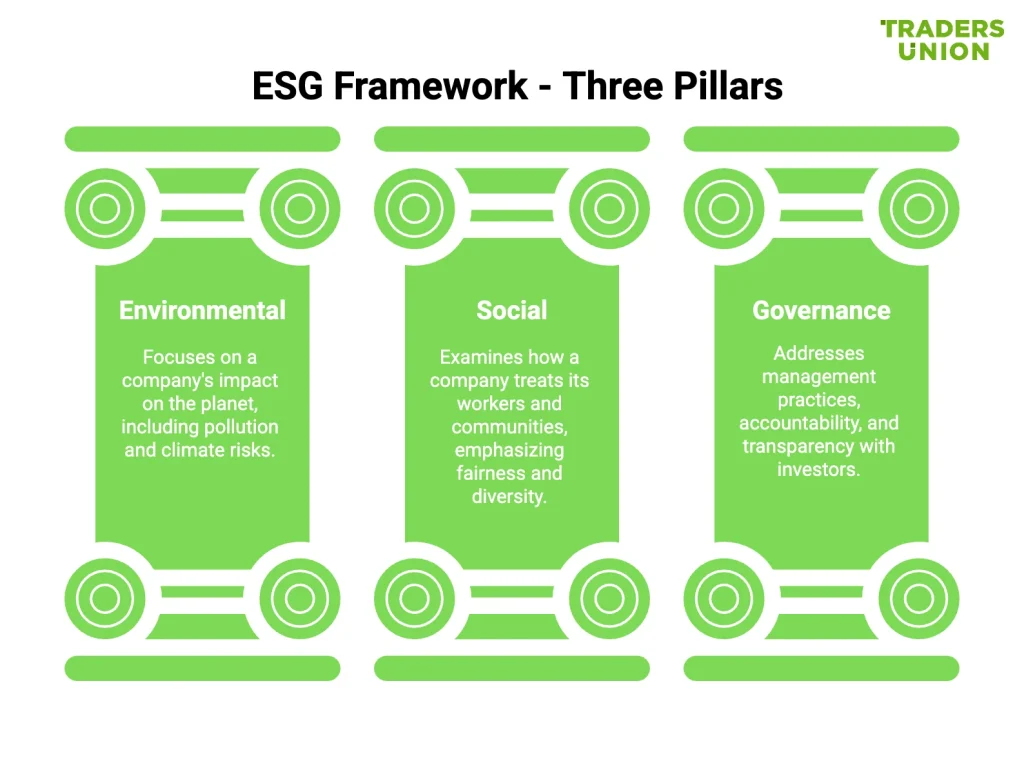Think of ESG as a way to look beyond just the dollar signs when it comes to businesses and investments. It’s about how companies treat the planet, how they interact with people, and how they’re actually run. It’s becoming clear that the financial performance of organizations is increasingly tied to environmental and social factors . We’re not just talking about being “nice guys” here; ESG is becoming a crucial lens through which investors and consumers are evaluating companies. This framework helps to identify potential risks and opportunities that might not be apparent when looking solely at traditional financial metrics .
Table of Contents
ToggleWhat Exactly is ESG? Let’s Break it Down.
At its core, ESG stands for Environmental, Social, and Governance . Simple enough, right? But each of these letters packs a punch. It’s essentially a set of standards that helps us understand how a company operates concerning our Earth and the folks living on it . More and more, folks who are thinking about putting their money into something (that’s investors like you and me, even on a small scale) are using these ESG ideas to see if a company is a good bet, not just financially, but also ethically . This approach acknowledges the growing assumption that a company’s financial well-being is intertwined with its environmental and social impact .
Think of it as a way to measure a company’s “good citizenship” – how they treat the environment, their employees, and their stakeholders . This involves looking at a broad range of behaviors and policies to assess a company’s responsibility . While you might hear terms like “sustainability” or “corporate social responsibility” (CSR) thrown around, ESG is a bit more concrete. It gives us the data and numbers to actually make informed decisions for both companies and investors . You might also hear it called sustainable investing, responsible investing, or even impact investing. They’re all in the same ballpark, focusing on more than just profits . These terms, while often used interchangeably, have subtle differences, with ESG focusing on measurable criteria alongside financial analysis .
Believe it or not, this isn’t a brand-new idea! People have been considering ethics in investments for centuries, but the term “ESG” really took off in the early 2000s . The evolution of terminology from Socially Responsible Investing (SRI) in the 1970s to the more encompassing ESG reflects a growing understanding of the interconnectedness of business, society, and the environment . Initially, ethical considerations were paramount, but the focus has broadened to include quantifiable metrics that can inform investment decisions and corporate strategies . The overlap in terminology can sometimes cause confusion, highlighting the need for clarity in understanding the nuances of each approach .
| Pillar | Focus | Example Factors |
|---|---|---|
| Environmental | Planet and Natural Resources | Climate change, greenhouse gas emissions, pollution, waste management, resource depletion, deforestation, biodiversity. |
| Social | People and Relationships | Labor practices, human rights, employee diversity, health and safety, community engagement, supply chain ethics, consumer protection. |
| Governance | Company Leadership and Accountability | Corporate leadership, executive compensation, board structure, shareholder rights, business ethics, transparency, bribery and corruption. |

The Three Pillars Holding Up ESG
Environmental: Taking Care of Our Planet
This is all about how a company interacts with Mother Earth. Are they being a good steward, or are they causing more harm than good?. Think about things like their carbon footprint – how much they’re contributing to climate change . Are they pumping out tons of greenhouse gases, or are they looking for cleaner ways to operate? This pillar examines issues like greenhouse gas emissions (GHG), deforestation, biodiversity, and carbon emissions . It also covers things like deforestation, how they manage waste and pollution, and whether they’re using our precious resources wisely . Are they guzzling water and energy, or are they finding ways to be more efficient? Factors such as resource depletion, water and energy efficiency, and the adoption of renewable energy sources are also key considerations . Basically, it’s about a company’s impact on the air we breathe, the water we drink, and the land we live on . Compliance with environmental regulations and the implementation of sustainable practices are crucial aspects of this pillar . The emphasis on environmental responsibility reflects a growing global awareness of the urgency of addressing climate change and protecting natural resources .
Social: People Matter Too
This pillar looks at how a company treats people – both inside and outside its walls . Are they creating a fair and inclusive workplace? Do they respect human rights throughout their supply chain?. Are they ensuring the safety and well-being of their employees? It also considers their relationships with the communities where they operate. Are they being good neighbors? Are they contributing positively or negatively?. This involves evaluating the company’s relationships with internal and external stakeholders . Things like labor practices, diversity and inclusion, and community engagement all fall under this important “S” . This includes examining working conditions, equal opportunities, health and safety, and the absence of child labor and slavery . Philanthropy and community engagement initiatives also demonstrate a company’s commitment to social responsibility . The focus on social factors underscores the understanding that a company’s success is linked to the well-being of its employees, customers, and the communities in which it operates .
Governance: How Things Are Run
This is about the nuts and bolts of how a company is actually managed and held accountable . Think about the folks at the top – the corporate leadership and the board of directors. Are they ethical and transparent in their decision-making?. Executive compensation is another big one. Are the big bosses getting unfairly huge payouts, or is it tied to the company’s overall performance and responsible practices?. It also looks at the rights of shareholders (the people who own a piece of the company) and whether they have a voice in how things are run . Good governance is about making sure a company is run with integrity and in the best interests of everyone involved . This pillar encompasses factors like business ethics, executive pay, board diversity and structure, bribery and corruption policies, and shareholder rights . Ensuring accurate and transparent accounting methods is also a crucial aspect of good governance . Strong corporate governance is often viewed as the bedrock for ensuring both environmental and social responsibilities are taken seriously within an organization .
Peeling Back the Layers: Diving Deeper into ESG Factors
The ‘E’ in ESG: A Look at Environmental Responsibilities
Tackling Climate Change: A Hot Topic
We’re talking about things like reducing those greenhouse gas emissions, figuring out a company’s carbon footprint, and even aiming for “net-zero” – meaning they’re not adding any extra carbon to the atmosphere . This involves strategies to mitigate climate change and reduce a company’s contribution to global warming .
Resource Depletion: Using Wisely What We Have
This means being smart about how much water and energy they use, and making sure they’re not just gobbling up natural resources without a second thought . Efficient use of resources is not only environmentally sound but can also lead to cost savings for companies .
Pollution Prevention: Keeping Our Air and Water Clean
From managing waste responsibly to preventing toxic spills, this is about making sure companies aren’t fouling our planet . And let’s not forget about protecting our forests and the amazing variety of life on Earth (biodiversity) . This includes managing toxic waste, reducing pollution, and addressing issues like deforestation and biodiversity loss .
The ‘S’ in ESG: Focusing on Social Impact
Fair Labor Practices: Treating Workers Right
Think about fair wages, safe working conditions, and making sure everyone has an equal shot at opportunities . This includes ensuring employee health and safety, promoting diversity and inclusion, and upholding basic labor standards .
Upholding Human Rights: A Universal Responsibility
This is a big one. It means ensuring there’s no child labor or forced labor in their operations or anywhere in their supply chain. It’s about respecting the basic rights of every individual involved with the company . This extends to addressing human rights issues throughout the organization’s value chain .
Strong Community Relations: Being a Good Neighbor
Companies aren’t islands. They exist within communities, and this factor looks at how well they engage with and contribute to those communities, maybe through local initiatives or charitable work . Plus, it’s about making sure everyone feels included and respected . This involves community engagement, philanthropy, and fostering positive relationships with the local population .
The ‘G’ in ESG: Examining Corporate Governance
Ethical Corporate Leadership: Setting the Right Tone
This is where integrity and transparency come into play. Are the leaders making decisions honestly and openly?. This includes preventing bribery and corruption and ensuring overall business ethics .
Executive Compensation: Fair Rewards?
It’s about making sure that how much the top folks get paid is reasonable and tied to how well the company is doing, including its ESG performance . This involves considering executive pay levels and their alignment with company performance and shareholder interests .
Shareholder Rights: Giving Owners a Voice
Shareholders have a stake in the company, and this looks at whether they have the ability to influence decisions and hold the company accountable . It also includes making sure the board of directors reflects a diverse range of perspectives . Ensuring accountability to shareholders and promoting transparency in corporate actions are key aspects here .
Why the Buzz? The Growing Importance of ESG
Let’s be real, people are increasingly worried about the planet and how businesses are impacting it . We’re seeing the effects of climate change, and folks are demanding action. And it’s not just about the environment. People care about how they’re treated, and they want to support companies that align with their values . This growing concern among the public directly influences investor decisions and consumer behavior .
Investors are also waking up to the fact that companies that do well on ESG factors tend to be more resilient and perform better in the long run . It’s not just about being good; it can be good for business! Think about it – a company with strong environmental practices might be less likely to face hefty fines or disruptions due to environmental regulations. A company that treats its employees well is more likely to have a happy and productive workforce. And a company with good governance is generally seen as more stable and trustworthy . This understanding of the potential for improved financial performance and better risk management is a significant driver of ESG adoption .
The rise of ESG investing shows that people are putting their money where their mouth is, actively choosing to invest in companies that are making a positive impact . ESG-specific mutual funds and ETFs have seen substantial growth, indicating a strong investor appetite for sustainable options . Even big global organizations like the United Nations have been pushing for ESG principles to create a more sustainable future . The UN’s Sustainable Development Goals (SDGs) provide a framework for global sustainability efforts, and ESG aligns with these broader objectives . The pandemic actually highlighted the importance of ESG, as companies with strong ESG practices often weathered the storm better . This demonstrated the resilience and adaptability of businesses that prioritize ESG factors . The increasing engagement of younger generations and women in investing, who often prioritize social and environmental impact, is also contributing to the ESG boom .
The Sweet Rewards: Benefits of Embracing Strong ESG Practices
Boosting the Bottom Line: Improved Financial Performance
Believe it or not, doing good can actually be good for your wallet! Studies have shown that companies with strong ESG practices can see better financial results in the long run . This can be attributed to factors like increased efficiency, reduced operational costs, and enhanced innovation . Sustainable funds have even been shown to perform just as well, if not better, than traditional investments, and they can even be less risky during tough economic times . Research suggests that sustainable funds often exhibit lower downside risk, meaning they have a lower potential for loss during market downturns .
Shining Reputation: Enhanced Brand Image
In today’s world, people care about where their products come from and who they’re supporting. Companies with a strong commitment to ESG often build a better reputation and attract more loyal customers . Consumers are increasingly willing to pay a premium for products and services from companies known for their ethical and sustainable practices . A positive ESG record can also enhance a company’s ability to attract and retain top talent .
Navigating the Storm: Better Risk Management
Thinking about environmental and social factors can help companies spot potential risks before they become major problems, like environmental disasters or social unrest . This can save them a lot of headaches (and money) down the line. By considering ESG factors, companies can better anticipate and mitigate risks related to climate change, resource scarcity, social unrest, and regulatory changes . This proactive approach can lead to greater long-term stability and resilience .
Not Always a Smooth Ride: Challenges in Implementing and Reporting ESG
Okay, let’s be honest, it’s not always easy for companies to jump on the ESG bandwagon. One of the big challenges is that there aren’t always clear, standardized rules for reporting on ESG factors . It can be like trying to compare apples and oranges. Different rating agencies use varying methodologies and criteria, leading to potential inconsistencies in ESG scores . This lack of uniformity can make it difficult for investors to accurately compare the sustainability performance of different companies .
Figuring out exactly how to measure and report on things like social impact can be tricky . What counts? How do you quantify it? Defining and measuring a company’s ESG performance can be complex and resource-intensive . There’s also the risk of “greenwashing,” where companies might try to make themselves look better than they actually are when it comes to ESG . It can be hard to tell who’s genuinely committed and who’s just putting on a show. This can erode trust in ESG initiatives if not addressed with transparency and accountability .
The rules and regulations around ESG are also constantly evolving, which can make it tough for companies to keep up . The regulatory landscape is becoming increasingly active, with new directives and reporting requirements emerging in various regions . Sometimes, there can be a lack of clear data or inconsistent information, making it hard to get a full picture of a company’s ESG performance . Ensuring data quality and transparency remains a key challenge in the field of ESG .
Gazing into the Crystal Ball: Future Trends in the World of ESG
The Rise of Regulation: More Rules of the Game
Expect to see more governments and regulatory bodies stepping in to create clearer guidelines and requirements for ESG reporting. For example, the European Union is already leading the way with things like the Corporate Sustainability Reporting Directive (CSRD), and other regions are likely to follow suit . This trend reflects a growing recognition of the importance of ESG in the broader economic and social context .
Standardization Efforts: Speaking the Same Language
There’s a big push to develop more consistent and comparable ESG reporting frameworks. This will make it easier for investors and other stakeholders to understand and compare companies’ ESG performance . Initiatives like the Taskforce on Climate-related Financial Disclosure (TCFD) and the Sustainability Accounting Standards Board (SASB) are important steps in this direction . The goal is to create a more unified and reliable system for measuring and reporting ESG data .
Wrapping Up: ESG – More Than Just a Trend
It’s clear that ESG is not just a passing fad. It represents a fundamental shift in how we think about business and investment, recognizing that long-term success is intertwined with environmental responsibility, social impact, and good governance. As awareness grows and regulations evolve, ESG will only become more crucial for companies and investors alike who are looking to build a more sustainable and equitable future.
Frequently Asked Questions (FAQs)
- Is ESG investing more expensive than traditional investing? Not necessarily. While some ESG-focused funds might have slightly higher expense ratios, many are competitively priced. Furthermore, the potential for long-term value creation and risk mitigation associated with ESG investing can outweigh any marginal cost differences.
- How can I tell if a company is truly committed to ESG or just greenwashing? It’s important to look beyond surface-level claims. Examine a company’s detailed sustainability reports, check their ratings from reputable ESG rating agencies, and see if their actions align with their stated commitments. Transparency and concrete data are key indicators of genuine commitment.
- Does focusing on ESG mean sacrificing financial returns? The evidence suggests otherwise. Many studies have shown that ESG-integrated investments can perform as well as or even outperform traditional investments over the long term. Considering ESG factors can actually lead to better-informed investment decisions and potentially lower risk.
- Who benefits from companies adopting strong ESG practices? The benefits are widespread. The environment benefits from reduced pollution and resource depletion. Society benefits from fair labor practices and community engagement. Investors benefit from potentially better returns and lower risks. And the companies themselves can benefit from enhanced reputation, improved efficiency, and long-term sustainability.
- What role do consumers play in driving ESG adoption? Consumers have a significant role to play. By choosing to support companies with strong ESG practices and holding companies accountable for their environmental and social impact, consumers can create market pressure that encourages businesses to prioritize ESG.







